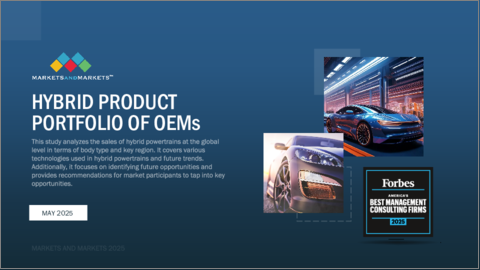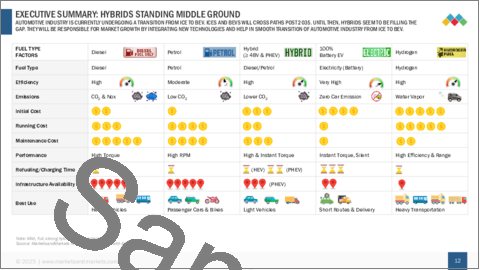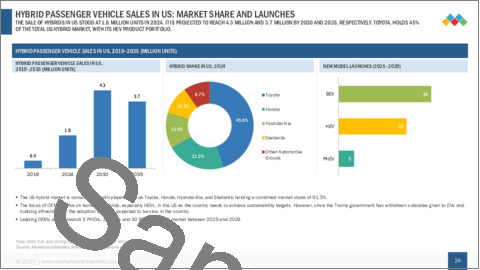|
|
市場調査レポート
商品コード
1757097
OEMのハイブリッド製品ポートフォリオの世界市場:推進タイプ別、ボディタイプ別、地域別 - 2030年までの予測Hybrid Product Portfolio of OEMs by Propulsion (ICE, HEV, PHEV, and BEV), Body Type (Hatchback, Sedan, SUV, MPV), and Region (Europe, NA, China, Asia (excl. China), and RoW) - Global Forecast to 2030 |
||||||
カスタマイズ可能
|
|||||||
| OEMのハイブリッド製品ポートフォリオの世界市場:推進タイプ別、ボディタイプ別、地域別 - 2030年までの予測 |
|
出版日: 2025年04月22日
発行: MarketsandMarkets
ページ情報: 英文 71 Pages
納期: 即納可能
|
全表示
- 概要
- 図表
- 目次
ハイブリッドの市場規模は、2024年の1,240万台からCAGR15.0%で2030年には2,850万台に成長すると予測されています。
市場全体の成長を後押ししているのは、ハイブリッド車の特性による継続的な採用の増加です。ハイブリッド車は、航続距離の不安、充電、バッテリー放電のない優れた効率を提供します。さらに、持続可能なパワートレインへの傾斜が、ハイブリッド市場の今後の成長を後押しします。
| 調査範囲 | |
|---|---|
| 調査対象年 | 2019年~2030年 |
| 基準年 | 2024年 |
| 予測期間 | 2025年~2030年 |
| 検討単位 | 台数(台) |
| セグメント別 | 推進タイプ別、ボディタイプ別、地域別 |
| 対象地域 | 北米、欧州、中国、アジア(中国を除く)、その他の地域 |
SUVはすでに新規顧客の間で好まれるボディタイプであることが証明されています。SUV市場は、様々な要因によって成長が見込まれています。自動車業界は、技術の進歩やエンドユーザーの嗜好による変化への対応を常に迫られています。ハイブリッドSUVの採用は、自動車市場に急速な変化をもたらした重要な要因です。ハイブリッド分野に沿って、最小限の排出ガスで自動車を開発・製造し、顧客のために政府の規制を満たすことは、OEMや自動車提供企業にとって極めて重要です。
さらに、操作機能を強化し、低排出ガスレベルを実現したハイブリッド技術のSUVを導入することで、自動車市場の動向は変化しています。さらにOEMは、ハイブリッド車の最適化によって操作できる機能を導入することで、車両の走行距離を伸ばすことに注力しています。
欧州は、先進技術の導入においてリーダー的存在です。同様にハイブリッド車の場合も、欧州が採用競争をリードしています。特にハイブリッドSUVでは、この地域が市場をリードしています。ハイブリッド車の採用は、欧州各国の政府が定めた厳しい排ガス規制によるものです。さらに、OEMメーカーと各国政府は、近い将来にゼロ・エミッション目標を達成しようと躍起になっています。EUの厳しい排ガス規制により、自動車メーカーはそれぞれの市場でハイブリッド車の発売を優先せざるを得なくなっています。ICEからBEVへのスムーズな移行には、ハイブリッドが不可欠なのです。
ハイブリッド車の販売台数では、中国の方が欧州に近い状況です。しかし、欧州の48Vマイルドハイブリッドやフル/ストロングハイブリッドとは異なり、中国はプラグインハイブリッド(PHEV)に注力しています。これは、中国の自動車製造からバッテリー製造までのEVサプライチェーンが優れているためです。PHEVでは中国が優勢で、BYDが市場をリードしています。
欧州地域は、Volkswagen(ドイツ)、Mercedes-Benz(ドイツ)、Stellantis(オランダ)、BMW(ドイツ)、Renault Group(フランス)など、主要なハイブリッド自動車OEMの大半の本拠地でもあります。また、中国は主要な自動車製造拠点であり、BYD、吉利集団、長城汽車(GMW)、長安汽車(Changan)、上海汽車(SAIC Motors)といった主要なハイブリッド自動車OEMの本拠地でもあります。
自動車セクターの継続的な発展と主要OEMの存在が、欧州と中国地域におけるハイブリッド市場の成長を促進すると思われます。
当レポートでは、世界のハイブリッド市場について調査し、推進タイプ別、ボディタイプ別、地域別動向、および市場に参入する企業のプロファイルなどをまとめています。
目次
- 調査範囲
- 調査目的、調査手法、主要情報領域
- 世界の乗用車販売台数(推進タイプ別)
- 世界の乗用車OEM販売台数(推進タイプ別)
- 世界のハイブリッド乗用車の販売台数(ハイブリッド推進タイプ別)
- 世界のハイブリッド乗用車の販売台数(ボディタイプ別)
- 世界のハイブリッド乗用車OEMシェア(ボディタイプ別)
- 世界のハイブリッド乗用車販売、市場シェア、新車発売、地域別
- 推進タイプ別の平均価格分析
- 推進タイプ別のTCO分析
- 推進タイプ別の部品表分析(2024年対2030年)
- ハイブリッドパワートレインの価値情勢
- ボディタイプ別駆動モータ特性分析
- ボディタイプ別、推進タイプ別の平均航続距離分析
- 回生ブレーキと航続距離回復分析
- ハイブリッドパワートレイン分析
- ハイブリッド駆動モータ解析
- TOYOTA GROUP
- BYD
- RENAULT-NISSAN-MITSUBISHI
- HYUNDAI-KIA
- HONDA
- STELLANTIS
- SUZUKI
- VOLKSWAGEN GROUP
- GEELY GROUP
- MERCEDES-BENZ GROUP
- GREAT WALL MOTORS
- LI AUTO
- BMW
- FORD MOTORS
List of Tables
List of Figures
The hybrid market is projected to grow from 12.4 million units in 2024 to 28.5 million units by 2030 at a CAGR of 15.0%. The overall market growth is propelled by the continuously increasing adoption of hybrid vehicles owing to their characteristics. Hybrids offer superior efficiency without range anxiety, charging, or battery discharge. Additionally, the inclination toward sustainable powertrains will help the hybrid market grow in the coming years.
| Scope of the Report | |
|---|---|
| Years Considered for the Study | 2019-2030 |
| Base Year | 2024 |
| Forecast Period | 2025-2030 |
| Units Considered | Volume (Units) |
| Segments | By Propulsion Type, Body Type, and Region. |
| Regions covered | North America, Europe, China, Asia, (excluding China), and the Rest of the World [RoW] |
"SUVs will be the fastest-growing segment in the hybrid market."
SUVs have already proved to be the preferred body type amongst new customers. The SUV market is expected to experience growth driven by various factors. The automotive industry is constantly pressured to adapt to changes due to technological advancements and end-user preferences. Adopting hybrid SUVs is the key factor that has witnessed a rapid change in the automotive market. In line with the hybrid sector, developing and manufacturing cars with minimum emissions and meeting the government regulations for customers are crucial for OEMs and vehicle-providing companies.
Further, introducing hybrid technology SUVs with enhanced operating features and lower emission levels is shifting the trends in the automotive market. Moreover, OEMs are focused on increasing the vehicle's mileage by introducing functionality that can be operated through hybrid vehicle optimization.
"Europe and China are the largest hybrid markets."
Europe is the leader in the adoption of advanced technologies. Similarly, in the case of hybrids, Europe is leading the adoption race. The region is a market leader, especially in hybrid SUVs. The adoption of hybrids is attributed to stringent emission norms set by the governments of the countries in Europe. Moreover, OEMs and governments are keen to achieve zero-emission targets in the near future. Strict EU emissions regulations have forced automakers to prioritize launches of hybrids in the respective markets. This is where hybrids are vital in a smooth transition from ICEs to BEVs.
China is closer to Europe in terms of hybrid sales. However, unlike 48V mild or full/strong hybrids in Europe, China is focused on plug-in hybrids (PHEVs). This is owing to China's superior EV supply chain, from car manufacturing to battery manufacturing. China dominates the PHEV offerings, where BYD leads the market.
The European region is also home to the majority of key hybrid automotive OEMs, such as Volkswagen (Germany), Mercedes-Benz (Germany), Stellantis (Netherlands), BMW (Germany), and Renault Group (France). China is also a major automotive manufacturing hub and home to most key hybrid automotive OEMs, such as BYD, Geely Group, Great Wall Motors (GMW), Changan, and SAIC Motors.
The ongoing developments in the automotive sector, coupled with the presence of key OEMs, will drive the growth of the hybrid market in the European and Chinese regions.
In-depth interviews were conducted with CEOs, marketing directors, other innovation and strategy directors, and executives from various key organizations operating in this market.
- By Company Type: Equipment Manufacturers - 90% and Others - 10%.
- By Designation: C-level - 40%, Directors- 40%, and Others - 20%
- By Region: Americas - 20%, Europe - 30%, Asia Pacific - 30%, and Middle East & RoW-20%
Established players such as Toyota (Japan), General Motors (US), Volkswagen (Germany), Hyundai Group (South Korea), and Ford Motors (US) lead the hybrid market.
Key Benefits of Buying the Report:
The report will help market leaders and new entrants with information on the closest approximations of the volume sales for the overall automotive market and the subsegments. It will also help stakeholders understand the competitive landscape and gain more insights to better position their businesses and plan suitable go-to-market strategies. The report also helps stakeholders understand the market's pulse and provides information on key market drivers, restraints, challenges, and opportunities.
The report provides insights on the following pointers:
Analysis of Key Drivers (Rapid electrification of vehicles is fueling the demand for hybrid vehicles, Government restrictions on emission and sustainable driving fuel options), Restraints (Higher cost of PHEVs), opportunities (Advancements in battery, Advancements in hybrid optimization technology and rapid adoption of alternate fuel options), and Challenges (Supply chain issues of battery raw material and battery related issues in hybrid cars) influencing the growth of hybrid market.
Product Development/Innovation: Detailed insights on upcoming technologies, R&D activities, and new products & services in the hybrid market.
Market Development: Comprehensive information about the lucrative market - the report analyzes the hybrid market across varied regions.
Market Diversification: Exhaustive information about new products & services, untapped geographies, recent developments, and investments in the hybrid market.
Competitive Assessment: In-depth assessment of market shares, growth strategies, and service offerings of leading players like Toyota (Japan), General Motors (US), Volkswagen (Germany), Hyundai Group (South Korea), and Ford Motors (US), among others, in the hybrid market.
TABLE OF CONTENTS
1. EXECUTIVE SUMMARY
2. RESEARCH SCOPE, OBJECTIVES, AND METHODOLOGY
- 2.1 STUDY SCOPE
- 2.2 STUDY OBJECTIVES, METHODOLOGY, AND KEY INFORMATION AREAS
3. GLOBAL HYBRID MARKET OUTLOOK
- 3.1 GLOBAL PASSENGER VEHICLE SALES, BY PROPULSION TYPE
- 3.2 GLOBAL PASSENGER VEHICLE OEM SALES, BY PROPULSION TYPE
- 3.3 GLOBAL HYBRID PASSENGER VEHICLE SALES, BY HYBRID PROPULSION TYPE
- 3.4 HYBRID PASSENGER VEHICLE SALES, BY BODY TYPE
- 3.5 GLOBAL HYBRID PASSENGER VEHICLE OEM SHARE, BY BODY TYPE
4. REGIONAL HYBRID MARKET OUTLOOK
- 4.1 REGIONAL HYBRID PASSENGER VEHICLE SALES, MARKET SHARE, AND NEW LAUNCHES
5. HYBRID MOBILITY PRICING ANALYSIS
- 5.1 AVERAGE PRICE ANALYSIS, BY PROPULSION TYPE
- 5.2 TCO ANALYSIS, BY PROPULSION TYPE
- 5.3 BILL OF MATERIAL ANALYSIS, BY PROPULSION TYPE, 2024 VS. 2030
- 5.4 HYBRID POWERTRAIN VALUE LANDSCAPE
6. HYBRID MOBILITY TECHNOLOGY ANALYSIS
- 6.1 DRIVE MOTOR CHARACTERIZATION ANALYSIS, BY BODY TYPE
- 6.2 AVERAGE RANGE ANALYSIS, BY BODY TYPE AND PROPULSION TYPE
- 6.3 REGENERATIVE BRAKING & RANGE RECOVERY ANALYSIS
- 6.4 HYBRID POWERTRAIN ANALYSIS
- 6.5 HYBRID DRIVE MOTOR ANALYSIS
7. HYBRID OEM PROFILING
- 7.1 TOYOTA GROUP
- 7.2 BYD
- 7.3 RENAULT-NISSAN-MITSUBISHI
- 7.4 HYUNDAI-KIA
- 7.5 HONDA
- 7.6 STELLANTIS
- 7.7 SUZUKI
- 7.8 VOLKSWAGEN GROUP
- 7.9 GEELY GROUP
- 7.10 MERCEDES-BENZ GROUP
- 7.11 GREAT WALL MOTORS
- 7.12 LI AUTO
- 7.13 BMW
- 7.14 FORD MOTORS
8. KEY GROWTH OPPORTUNITIES AND RECOMMENDATIONS
9. CONCLUSION AND KEY TAKEAWAYS
10. LEGAL DISCLAIMER






